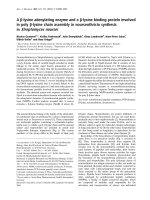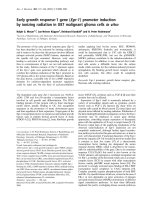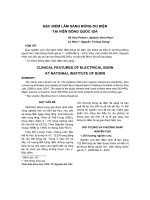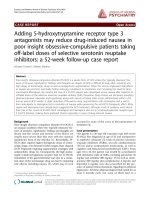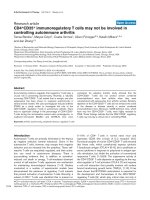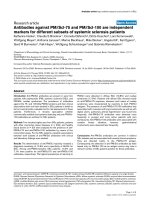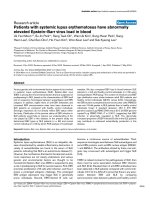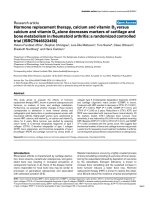Báo cáo y học: "Commonly applied positive end-expiratory pressures do not prevent functional residual capacity decline in the setting of intra-abdominal hypertension: a pig model" pot
Bạn đang xem bản rút gọn của tài liệu. Xem và tải ngay bản đầy đủ của tài liệu tại đây (643.97 KB, 11 trang )
RESEARC H Open Access
Commonly applied positive end-expiratory
pressures do not prevent functional residual
capacity decline in the setting of intra-abdominal
hypertension: a pig model
Adrian Regli
1*
, Lisen E Hockings
1
, Gabrielle C Musk
2
, Brigit Roberts
1
, Bill Noffsinger
3
, Bhajan Singh
3
,
Peter V van Heerden
1
Abstract
Introduction: Intra-abdominal hypertension is common in critically ill patients and is associated with increased
morbidity and mortality. The optimal ventilation strategy remains unclear in these patients. We examined the effect
of positive end-expiratory pressure s (PEEP) on functional residual capacity (FRC) and oxygen delivery in a pig
model of intra-abdominal hypertension.
Methods: Thirteen adult pigs received standardised anaesthesia and ventilation. We randomised three levels of
intra-abdominal pressure (3 mmHg (baseline), 18 mmHg, and 26 mmHg) and four commonly applied levels of
PEEP (5, 8, 12 and 15 cmH
2
O). Intra-abdominal pressures wer e generated by inflating an intra-abdominal balloon.
We measured intra-abdominal (bladder) pressure, functional residual capacity, cardiac output, haemoglobin and
oxygen saturation, and calculated oxygen delivery.
Results: Raised intra-abdo minal pressure decreased FRC but did not change cardiac output. PEEP increased FRC at
baseline intra-abdominal pressure. The decline in FRC with raised intra-abdominal pressure was partly reversed by
PEEP at 18 mmHg intra-abdominal pressure and not at all at 26 mmHg intra-abdominal pressure. PEEP significantly
decreased cardiac output and oxyg en delivery at baseline and at 26 mmHg intra-abdominal pressure but not at
18 mmHg intra-abdominal pressure.
Conclusions: In a pig model of intra-abdominal hypertension, PEEP up to 15 cmH
2
O did not prevent the FRC
decline caused by intra-abdominal hypertension and was associated with reduced oxygen delivery as a
consequence of reduced cardiac output. This implies that PEEP levels inferior to the corresponding intra-abdominal
pressures cannot be recommended to prevent FRC decline in the setting of intra-abdominal hypertension.
Introduction
Intra-abdominal hypertension (IAH) is defined by the
World Soci ety of Abdominal Compartment Syndrome as
a sustained increase in intra-abdominal pressure (IAP)
above or equal to 12 mmHg and abdominal compartment
syndrome is defined as an IAP of more than 20 mmHg
plus a new organ d ysfunction [1] . IAH a nd abdominal
compartment syndrome are common in critically ill
patients and are associated with a high rate of morbidity
and mortality [1-6]. IAH is associated with an increased
systemic vascular resistance, a decreased ve nous return
and a reduced cardiac output subsequently leading to
reduced renal, hepatic and gastro-intestinal perfusion and
thereby promoting multi organ failure [7-12].
Patients with IAH are susceptible to a significant
impairment in lung function mainly caused by atelecta-
sis resulting from a cephaled shift of the diaphragm,
with subsequent decrease in lung volume leading to a
decrease in arterial oxygenation [12-14]. Atele ctasis is
generally treated by recruitment manoeuvres followed
by increasing positive end expiratory pressure (PEEP) in
* Correspondence:
1
Intensive Care Unit, Sir Charles Gairdner Hospital, Hospital Avenue, Nedlands
(Perth) WA 6009, Australia
Regli et al. Critical Care 2010, 14:R128
/>© 2010 Regli et al.; licensee BioMed Central Ltd. This is an open access article distributed under the terms of the Creative Commons
Attribution Lice nse ( which permits unrestricted us e, distri bution, and reproduction in
any mediu m, provided the original work i s properly cited.
patients receiving mechanical ventilation [14-17]. How-
ever, in the setting of IAH, the role of PEEP remains
unclear. On one hand increased levels of PEEP have
been proposed to improve lung function [13,18]. On the
other hand low levels of PEEP have been suggested to
avoid haemodynamic compromise [7].
The correct diagnosis and treatment of the underlying
condition and, where medical treatment fails and as a
last resort, the performance of a decompressive laparot-
omy is recommended in patients with severe IAH (> 25
mmHg) [2]. How ever, in patients with less s evere IAH
or prior abdominal surgery in patients with severe IAH,
the World Society of Abdominal Compartment Syn-
drome recommends that cardiac output (CO) and oxy-
gen delivery ( DO
2
) should be optimized, as this has
been associated wit h a reduced morbidity and mortality
in these patients [2,8].
The aim of this project was to study the effect of com-
monly applied PEEP levels on FRC, arterial oxygen
saturation, CO and DO
2
in a healthy pig model of IAH.
We hypothesized that PEEP would increase FRC and
decrease CO and that there would be a PEEP level at
which DO
2
wouldbeoptimal.Wealsohypothesized
that high levels of PEEP would increase IAP.
Materials and methods
The study conformed to the regulations of the Austra-
lian code of practice for the care and use of animals for
scientific purposes and was approved by the Animal
Ethics Committee of the University of Western
Australia.
Preparation of animals and anaesthesia
We studied 13 pigs (Large White breed), which were
fasted overnight, but with free access to water. Each of
the animals was weighed and then sedated with an
intramuscular injection of Zoletil® ( 1:1 combination of
tiletamine and zolazepam, Virbac, Milperra, NSW, Aus-
tralia) (4 mg/kg) and xylazine (2 mg/kg). Venous access
was then established and secured in an auricular vein.
To facilitate endotracheal intubation, an intravenous
(IV) bolus of propofol (1 mg/kg) was a dministered. The
trachea was intubated via the oral route with a cuffed
endotracheal tube (size 8.0 mm, Hi-Lo, Mallinckrodt,
Athlone, Ireland). Anaesthesia was maintained with a
combination of propofol (9 to 36 mg/kg/h IV), mor-
phine (0.1 to 0.2 mg/kg/h IV) and ketamine (0.3 to 0.6
mg/kg/h IV) according to clinical requirements. Neuro-
muscular blocking agents were not administered. A core
temperature of 36°C to 38°C was maintained by the
application of heating mats.
Succinylated gelatin (Gelofusine, Braun, Oss, The Neth-
erlands) was given pre-emptively for haemodynamic stabi-
lization (500 mL over the first 30 minutes followed by 1
mL/kg/h). At the end of the protocol the pigs were eutha-
nized with p entobarbitone (100 mg/kg body weight),
injected IV.
Ventilation
A critical care ventilator (Servo 900, Siemens, Berlin,
Germany) was used with the following ventilator set-
tings: FiO
2
0.4, volume control mode, I:E ratio of 1:2,
tidal volume of 8 ml/kg with the respiratory rate
adjusted to maintain an end tidal CO
2
of 35 to 45
mmHg. The initial PEEP setting was 5 cmH
2
O(3.7
mmHg) and altered according to the experimental pro-
tocol. Peak airway pressure (pPaw), mean airway pres-
sure (mPaw), and dynamic complianc e (Cdyn) were
measured by the ventilator.
Surgical procedure
Throughout the study the animals remained supine. Fol-
lowing a chlorhexidine based antiseptic skin preparation
the pigs were instrumented as follows:
Haemodynamic monitoring
A 16-gauge single lumen catheter (ES-04301, Arrow
International, Reading, PA, USA) was inserted into the
femoral artery to measure the mean arterial blood pres-
sure (MAP). An 8.5F percutaneous introducer (SI-
0980 6, Arro w International) was inserted into the inter-
nal jugular vein to allow the placement of a pulmonary
artery catheter (AH-05050, Arrow International) under
continuous pressure wave monitoring into the pulmon-
ary artery in order to measure CO.
Intra-abdominal pressure measurement and generation
For the measurement of IAP, a caudal midline laparo-
tomy was performed to p lace a 12F Foley catheter
(226512, Bard, Covington, GA, USA) in the urinary
bladder.
For the generation of different levels of IAP, we per-
formed another cephaled midline laparotomy in order
to place a latex balloon (200 g weather balloon, Scienti-
fic Sales, Lawrencevill e, NJ, USA) in the peritoneal cav-
ity. The abdomen was tightly closed with sutures.
Inflation of the intra-abdominal balloon with air allowed
the generation of different levels of IAP [19].
We measured I AP using urinary bladder pressure as
defined by the World Society of Abdominal Compart-
ment Syndrome with the only difference that we mea-
sured mean IAP ins tead of end-e xpirator y IAP [1]. We
used a standardised injection volume of normal saline
(25 ml syringe with auto-valve, AbViser, Wolfe Tory
Medical , Salt Lake City, UT, USA). We measured urinary
bladder pressure before and after alterations of PEEP.
Experimental protocol
After a set of baseline measurements, the abdominal
balloon was either not inflated (baseline IAP) or inflated
Regli et al. Critical Care 2010, 14:R128
/>Page 2 of 11
with air to produce grade II (18 +/- 2 mmHg) or grade
IV (26 +/- 2 mmHg) IAH in predefined random order
[1]. PEEP was then applied in a predefined random
manner at 5, 8, 12 or 15 cmH
2
O (3.7, 5.9, 8.8, and 11.0
mmHg, respectively) at each level of IAP; these are com-
monly used lev els of PEEP in critically ill patients. For
randomisation, we used a spitplotdesignensuringall
12 combinations of IAH and PEEP levels were applied
to all animals [20].
For each IAP and PEEP setting, we performed a stan-
dardised lung recruitment manoeuvre as follows [21].
PEEP was increased every respiratory cycle by incre-
ments of 2 cmH
2
O (1.5 mmHg) in order to achieve
either a PEEP value of 15 cmH
2
O(11.0mmHg)ora
maximum peak airway pressure of 40 cmH
2
O
(29.4 mmHg) and then continued for 10 consecutive
breaths. Thereafter the PEEP was decreased by 2
cmH
2
O (1.5 mmHg) decrements per respiratory cycle
until the target PEEP setting was achieved according to
the experimenta l protocol. All respiratory and haemody-
namic measurements were then performed after a five-
minute period allowing for abdominal, respiratory and
haemodynamic stabilization.
Measurements and calculations
Haemodynamic parameters
All pressures including IAP were measured with a trans-
ducer (Hospira, Lake Forest, IL, USA) and monitored
with a critical care monitor (Sirecust 126; Siemens Med-
ical Electronics, Danvers, MA, USA). MAP, central
venous pressure (CVP) and heart rate (from electro-car-
diogram) were measured. All pressures were zeroed at
the mid axillary line, including urinary bladder pressure
[1]. CO was measured by thermodilution using a stan-
dardised 10 ml bolus of ice cold normal saline (Sirecust
126; Siemens Medical Electronics). For each IAP and
PEEP setting, three CO measurements were performed
and averaged.
Functional residual capacity
FRC was measured using the multiple breath nitrogen
wash-out method [22]. After switch ing FiO
2
from 0.4 to
1.0 an air tight bag collected the expiratory gas from the
ventilator until < 0.5% nitrogen was detectable. The
total expired gas volume was measured using a digital
pneumotachograph (HP 47303A, Hewlett-Packard, Para-
nus, NJ, USA) and nitrogen concentration was measured
with a nitrogen analyzer (HP 47302A, Hewlett-Packard)
after mixing the expired gas. Three FRC measurements
for each IAP and PEEP setting were performed and
averaged.
Oxygenation
Arterial oxygen tension (PaO
2
) and haemoglobin con-
centration (Hb) were measured with a blood gas
machine (ABL77, Radiometer, Copenhagen, Denmark)
immediately following collection . Blood was drawn from
the femoral artery and pulmonary artery in order to
measure arterial, and mixed venous oxygen tensions,
respectively.
Calculations
The following calculations were made from the measured
variables: Abdominal perfusion pressure (APP) = MAP -
IAP [1]. Systemic vascular resistance (SVR) = (MAP -
CVP)/CO × 79.9 dyn × s/cm
5
.PaO
2
was corrected for
pH (PaO
2
cor) = PaO
2
x 10 (0.30 × (pH-7.4) [23]. Oxygen
saturation = 100 × (0.13534 × PaO
2
cor)
3.02
/((0.13534 ×
PaO
2
cor)
3.02
+ 91.2)) [23]. Oxygen content = oxygen
saturation × (%/100) × Hb (g/dl) × 1.39 (ml/g) + 0.003
(ml/dl) × PO
2
cor) [24]. DO
2
= CO × arterial oxygen
content [24]. FRC = ((total expired gas volume × nitrogen
concentration)/(100 × 0.6)) - 1.92 (measured dead space
of ventilator).
Statistics
To detect a difference in DO
2
of 3.0 ml/kg/min (assum-
ing a mean (SD) DO
2
of 18.0 (4.0) ml/kg/minute) [25]
between two different PEEP values ( a = 0.05, power =
80%) we calculated a sample size of 13 pigs. Data are
reported as mean (SD), as the data proved to be nor-
mally distributed, when analyzed by the Kolmogorov-
Smirnov test. To compare the data between the different
combinations of PEEP and IAP, an ANOVA for
repeated measures was p erformed and a post hoc Stu-
dent-Newman-Keu ls-test to adjust for multiple compari-
sons. A probability of < 0.05 was considered statistically
significant.
Results
Mean (SD) animal weight was 42 (8) kg. Haemoglobin
concentration was 103 (8) g/L. After inflation of the
intra-abdominal balloon to t he target IAP, the IAP
remained constant over the five-minute stabilising per-
iod. The resulting level of IAP at the time of measure-
ment was: 3 (2), 18 (3), and 26 (4) mmHg for baseline,
grade II IAH, and grade IV IAH settings, respectively.
There were no differe nces between the measured para-
meters at baseline IAP and 5 cmH
2
O PEEP taken before
and during the randomized protocol. An adjustment of
the values according to the weight of the individual ani-
mal did not a lter the findings, therefore absolute values
are given. The influence of IAP and PEEP on haemody-
namic a nd respiratory parameters is shown in Tables 1,
2 and 3, and Figures 1, 2, 3 and 4. Increasing PEEP
from 5 to 15 cmH
2
O (3.7 to 11.0 mmHg) did not signif-
icantly increase IAP (+0.4 (0.8) mmHg).
Effect of IAP on FRC, and PaO
2
SaO
2
was 99.7 (0.2)% at all levels of IAP and PEEP.
IAH was associated with lower levels of PaO
2
.How-
ever, differences in PaO
2
were only significant at 8 and
Regli et al. Critical Care 2010, 14:R128
/>Page 3 of 11
12 cmH
2
O of PEEP when comparing the differences
between baseline IAP and 18 and 26 mmHg IAP
(Tables 1, 2 and 3). Increasing levels of IAP were asso-
ciated with a decrease in FRC by 33 (15)% and 30
(18)% for grade II and grade IV IAH, respectively
(Figure 1).
Effect of PEEP at different levels of IAP on FRC, and PaO
2
PEEP did not improve PaO
2
(Tables 1, 2 and 3). The
effect of PEEP on FRC varied at different levels of IAP.
At baseline IAP, PEEP increased FRC (Figure 1). At
grade II IAH, but not at grade IV IAH, the IAP induced
FRC decline partially reversed with increasing levels of
Table 1 Influence of positive end-expiratory pressure on respiratory and haemodynamic data at baseline intra-
abdominal pressure
PEEP, cmH
2
O 5 8 5 vs 8 12 5 vs 12 15 5 vs 15
FRC, L 1.4 (0.4) 1.5 (0.5) NS 1.7 (0.5) 0.002 1.7 (0.6) < 0.001
PaO
2
, mmHg 237 (14) 240 (19) NS 236 (16) NS 227 (25) < 0.05
pPaw, cmH
2
O 21 (6) 24 (5) < 0.001 27 (5) < 0.001 32 (5) < 0.001
mPaw, cmH
2
O 10 (1) 13 (2) < 0.001 16 (2) < 0.001 19 (1) < 0.001
C dyn, ml/cmH
2
O 25 (8) 25 (9) NS 24 (9) NS 21 (6) < 0.001
CO, L/min 3.5 (1.0) 3.2 (1.0) NS 2.7 (0.7) 0.009 2.5 (0.7) 0.002
DO
2
, ml/min 498 (156) 459 (156) NS 381 (112) 0.006 349 (100) < 0.001
SvO
2
, % 62 (7) 55 (11) < 0.05 47 (13) < 0.05 44 (17) < 0.05
VO
2
, ml/min 191 (47) 209 (70) NS 205 (81) NS 196 (53) NS
MAP, mmHg 71 (19) 67 (15) NS 60 (13) 0.025 56 (21) 0.004
APP, mmHg 69 (19) 64 (15) NS 56 (13) 0.01 53 (21) 0.002
CVP, mmHg 8 (4) 8 (3) NS 9 (2) NS 10 (3) NS
PAOP, mmHg 6 (2) 6 (2) NS 8 (2) 0.004 9 (1) < 0.001
HR, beats/min 79 (13) 81 (18) NS 85 (20) NS 89 (24) 0.026
SVR, dyn * s/cm
5
1,389 (408) 1,404 (352) NS 1,445 (373) NS 1,337 (321) NS
SV, ml 50 (21) 44 (13) NS 37 (12) 0.002 33 (10) < 0.001
APP, abdominal perfusion pressure; Cdyn, dynamic compliance; CO, cardiac output; CVP, central venous pressure; DO
2
, oxygen delivery; FRC, functional residual
capacity; HR, heart rate; MAP, mean arterial pressure; mPaw, mean airway pressure; PaO
2
, arterial oxygen tension; PAOP, pulmonary artery occlusion pressure;
PEEP, positive end-expiratory pressure; pPaw, peak airway pressure; SV, stroke volume; SvO
2
, mixed venous oxygen saturation; SVR, systemic vascular resistance;
VO
2
, oxygen consumption. Mean (SD) are given. ANOVA and post hoc Student-Newman-Keuls were used for statistical testing. NS, not significant (P > 0.05).
Table 2 Influence of positive end-expiratory pressure on respiratory and haemodynamic data at 18 mmHg intra-
abdominal pressure
PEEP, cmH
2
O 5 8 5 vs 8 12 5 vs 12 15 5 vs 15
FRC, L 0.9 (0.3) * 1.0 (0.3) * 0.034 1.0 (0.3) * 0.049 1.1 (0.3) * < 0.001
PaO
2
, mmHg 215 (32) 218 (20) * NS 222 (23) * NS 216 (26) NS
pPaw, cmH
2
O 29 (5) * 31 (5) * < 0.001 34 (5) * < 0.001 37 (5) * < 0.001
mPaw, cmH
2
O 12 (3) * 15 (3) * < 0.001 18 (3) * < 0.001 21 (4) * < 0.001
C dyn, ml/cmH
2
O 15 (4) * 15 (3) * NS 16 (4) * NS 16 (4) * NS
CO, L/min 3.5 (0.9) 3.4 (0.7) NS 3.4 (0.9) NS 3.1 (0.8) * NS
DO
2
, ml/min 490 (130) 472 (91) NS 472 (124) * NS 428 (116) * NS
SvO
2
, % 61 (9) 61 (10) NS 58 (11) * NS 56 (14) * NS
VO
2
, ml/min 195 (64) 192 (50) NS 202 (55) NS 186 (47) NS
MAP, mmHg 83 (12) 79 (11) * NS 81 (16) * NS 72 (13) * < 0.001
APP, mmHg 65 (13) 62 (12) NS 63 (18) NS 56 (12) 0.013
CVP, mmHg 10 (3) * 11 (2) * NS 13 (4) * < 0.001 15 (1) * < 0.001
PAOP, mmHg 7 (2) 9 (1) * < 0.001 11 (2) * < 0.001 12 (1) * < 0.001
HR, beats/min 73 (16) 72 (14) NS 74 (14) NS 76 (14) NS
SVR, dyn * s/cm
5
1,643 (364) 1,600 (217) * NS 1,580 (248) NS 1,491 (275) NS
SV, ml 52 (23) 49 (10) * NS 47 (14) * NS 42 (12) * NS
APP, abdominal perfusion pressure; Cdyn, dynamic compliance; CO, cardiac output; CVP, central venous pressure; DO
2
, oxygen delivery; FRC, functional residual
capacity; HR, heart rate; MAP, mean arterial pressure; mPaw, mean airway pressure; PaO
2
, arterial oxygen tension; PAOP, pulmonary artery occlusion pressure;
PEEP, positive end-expiratory pressure; pPaw, peak airway pressure; SV, stroke volume; SvO
2
, mixed venous oxygen saturation; SVR, systemic vascular resistance;
VO
2
, oxygen consumption. Mean (SD) are given. ANOVA and post hoc Student-Newman-Keuls were used for statistical testing. *, significant (P < 0.05) difference
compared with baseline IAP. NS, not significant.
Regli et al. Critical Care 2010, 14:R128
/>Page 4 of 11
PEEP. When PEEP was increased from 5 to 15 cmH
2
O
(3.7 to 11.0 mmHg), FRC increased by 0.3 (0.3) L (23
(18)%) at baseline IAP and 0.2 (0.1) L ((20 (11)%) at IAP
18 cmH
2
O.
Effect of IAP on CO, DO
2
, SvO
2
, and SVR
IAH did n ot significantly change CO and DO
2
at 5
cmH
2
O of PEEP (Figures 2 and 3, and Tables 1, 2 and 3).
Effect of PEEP at different levels of IAP on CO, DO
2
SvO
2
,
and SVR
PEEP was associated with a dose-related decrease in CO
and DO
2
at baseline IAP and at grade IV IAH, b ut not
at grade II IAH (Figures 2 and 3). When PEEP was
increased from 5 to 15 cmH
2
O (3.7 to 11.0 mmHg),
DO
2
decreased by 151 (158) ml/minute (25 (28)%) at
baseline IAP and by 100 (72) ml/minute (20 (20)%) at
grade IV IAH.
The changes in SvO
2
caused by IAH and PEEP paral-
leled those of CO. SVR increased significantly with
rising IAP, but not with increasing PEEP.
Discussion
Ther e are many studies examining the infl uence of IAH
on haemodynamic or on respiratory parameters. How-
ever, there are only a few studies investigating the effect
of IAP a nd PEEP on cardio-respiratory parameters
[26-28]. To our knowledge, this is the first study to
assess the effect of different levels of PEEP in the setting
of different levels of IAP o n lung volumes assessed by
FRC and CO parameters in a healthy pig model.
Effect of IAP and PEEP on FRC, and PaO
2
We found that increasing IAP from baseline to gra de II
IAH decreased FRC and PaO
2
levels by approximately
30% and 10%, respectively. There was no further
decrease in FRC and PaO
2
when IAP was increased
from grade II to grade IV IAH. This suggests either a
high impedance to further lengthening and cephalic
motion of the diaphragm or compensatory lung expan-
sion due to expansion of the rib cage.
Even in the absence of IAH, a healthy patient requir-
ing mechanical ventilation will experience some degree
of FRC reduction due to atelectasis [24]. Although the
role of PEEP in acute lung injury and acute respiratory
distress syndrome remains controversial, recruitment
manoeuvres and high levels of PEEP have been shown
to re-open collapsed alveoli and keep the alveoli open
[17,24]. As expected in this healthy pig lung model, in
the absence of IAH, PEEP increased FRC but did not
increase the already high PaO
2
levels.
InthepresenceofIAH,PEEPupto15cmH
2
Oonly
partially reversed the IAP, induced FRC decline in grade
II IAH, and did not increase FRC in grade IV IAH.
PEEP did not increase PaO
2
values in IAH.
The minimal PaO
2
decrease as compared to the rela-
tively larger FRC decrease in the setting of raised IAP
can be explained by the FRC not dropping below the
Table 3 Influence of positive end-expiratory pressure on respiratory and haemodynamic data at 26 mmHg intra-
abdominal pressure
PEEP, cmH
2
O 5 8 5 vs 8 12 5 vs 12 15 5 vs 15
FRC, L 1.0 (0.2) * 1.0 (0.3) * NS 1.0 (0.3) * NS 1.0 (0.2) * NS
PaO
2
, mmHg 213 (24) 215 (21) * NS 212 (21) * NS 212 (23) NS
pPaw, cmH
2
O 33 (4) * 36 (4) * < 0.001 38 (5) * < 0.001 42 (4) * < 0.001
mPaw, cmH
2
O 13 (4) * 16 (4) * < 0.001 19 (4) * < 0.001 22 (4) * < 0.001
C dyn, ml/cmH
2
O 13 (3) * 13 (3) * NS 13 (4) * NS 12 (3) * NS
CO, L/min 3.2 (1.0) 2.6 (0.6) * < 0.001 2.7 (0.9) < 0.001 2.5 (0.8) < 0.001
DO
2
, ml/min 449 (161) 367 (93) * 0.035 377 (140) 0.029 349 (124) 0.005
SvO
2
, % 58 (9) 54 (14) 0.007 53 (15) * 0.02 52 (13) 0.045
VO
2
, ml/min 188 (38) 179 (42) NS 183 (54) NS 165 (32) NS
MAP, mmHg 78 (13) 74 (18) NS 74 (15) * NS 76 (17) * NS
APP, mmHg 52 (14) * 48 (15) * NS 48 (15) NS 49 (17) NS
CVP, mmHg 11 (3) * 12 (2) * NS 13 (2) * 0.012 17 (3) * < 0.001
PAOP, mmHg 9 (2) 11 (4) * 0.024 12 (2) * 0.007 14 (3) * < 0.001
HR, beats/min 72 (10) 78 (14) NS 76 (13) NS 80 (16) NS
SVR, dyn * s/cm
5
1,771 (446) 1813 (404) * NS 1,861 (490) * NS 1,891 (419) * NS
SV, ml 44 (12) 37 (14) * 0.024 39 (18) 0.037 33 (12) 0.002
APP, abdominal perfusion pressure; Cdyn, dynamic compliance; CO, cardiac output; CVP, central venous pressure; DO
2
, oxygen delivery; FRC, functional residual
capacity; HR, heart rate; MAP, mean arterial pressure; mPaw, mean airway pressure; PaO
2
, arterial oxygen tension; PAOP, pulmonary artery occlusion pressure;
PEEP, positive end-expiratory pressure; pPaw, peak airway pressure; SV, stroke volume; SvO
2
, mixed venous oxygen saturation; SVR, systemic vascular resistance;
VO
2
, oxygen consumption. Mean (SD) are given. ANOVA and post hoc Student-Newman-Keuls were used for statistical testing. *, significant (P < 0.05) difference
compared with baseline IAP. NS, not significant.
Regli et al. Critical Care 2010, 14:R128
/>Page 5 of 11
closing capacity of healthy lungs and therefore not
resulting in atelectasis, shunting and consecutively
impaired gas exchange [24,29]. In the setting of acute
respiratory distress syndrome where the closing capacity
is increased, small decreases in FRC reductions may
cause marked reductions in PaO
2
. However, this would
need to be confirmed in further studies.
We chose PEEP levels of 5 to 15 cmH
2
Oasthese
represent PEEP levels frequently applied in critical ill
patients. The minimal effect of PEEP on reversing the
IAH induced FRC reduction can be explained by the
reduced estimated trans-pulmonary end-expiratory pres-
sures (PEEP - IAP) which would have approximated 8,
-7 and -15 mmHg at PEEP of 15 cmH
2
O (11.0 mmHg)
and at IAP of 3 mmHg (baseline), 18 mmHg (grade II
IAH), and 26 mmHg (grade IV IAH), respectively.
Therefore, with regards to improving FRC and PaO
2
,
PEEP values that are equal or higher than the corre-
sponding IAP value might be necessary to protect
against IAH induced FRC and PaO
2
decrease as has pre-
viously been suggested [13]. Howev er, when higher
PEEP levels are applied in the setting of IAH, the poten-
tial detrimental effect of high PEEP levels on CO and
DO
2
should be considered and balance d against the
lowest applicable PEEP in order to avoid haemodynamic
compromise in this setting [7].
Effect of IAP and PEEP on CO, DO
2,
and SvO
2
In agreement with other studies [29,30], we found that
PEEP caused a dose-dependent decrease in stroke
Figure 1 Influence of intra-abdominal pressure and positive end-expiratory pressure on functional residual capacity. Functional residual
capacity (FRC) in litres (L) in function of different levels of intra-abdominal pressures (IAP) (3 mmHg (baseline), 18 mmHg (grade II intra-
abdominal hypertension), and 26 mmHg (grade IV intra-abdominal hypertension)) at different levels of positive end-expiratory pressures (PEEP).
Mean and SE are shown. ANOVA and post hoc Student-Newman-Keuls were used for statistical testing. *, P < 0.05 within an IAP setting vs. the
corresponding value at 5 cmH
2
O PEEP. For clarification additional symbol is added where necessary. At each PEEP setting, all FRC values were
significantly different compared to the corresponding value at baseline IAP (P < 0.05).
Regli et al. Critical Care 2010, 14:R128
/>Page 6 of 11
volume and CO and DO
2
(Tables 1, 2 and 3, Figures 1
and 2) which can be attributed to a reduction in venous
return [29].
The effect of IAH on CO is controversial with some
studies showing a decrease in CO, while other studies do
not show a change or even an increase in CO in the pre-
sence of IAH [7,10-12,31]. This controversy can be
explained by IAH having a biphasic and potentially
opposing effect on CO which itself may be explained by
the dep endence of venous return on the level of IAP
[7,10,31]. Low levels of IAP have been show n to increase
venous return as a result of a re distribution of abdominal
blood to the thoracic compartment, thus increasing
stroke volume and CO [10,31]. However, further increase
in IAP overcomes the compensatory effect of blood redis-
tribution from the abdominal compartment to the thor-
acic compartment decreasing venous return and
thereforestrokevolumeandCO[10,31].Inourstudy,
IAH did not significantly reduce stroke volume, CO and
DO
2
when low levels of PEEP were applied (5 cmH
2
O,
3.7 mmHg). In agreement with other studies [7,11,12],
we also found that SVR increased with rising IAP, which
may be associated with a reduction in CO and DO
2
.
We found that even modest levels of PEEP
depressed CO to a greater extent than IAH alone.
This finding is supported by greater depression in
SvO
2
with PEEP, than with IAP (Figure 4). These
findings suggest that PEEP may be detrimental by
reducing DO
2
and failing to recruit atelectatic lung. If
increased levels of PEEP are indicated in the clinical
setting, it might be prudent to assess CO and arter ial
oxygen saturation before and after increasing the level
of PEEP in order to ascertain that the beneficial effect
of PEEP with increasing FRC and oxygenation is not
offset by a detrimental effect on CO, with a subse-
quent decrease in DO
2
.
Figure 2 Influence of intra-abdominal pressure and positi ve end-expiratory press ure on cardiac output. Cardiac output in L/minute in
function of different levels of intra-abdominal pressures (IAP) (3 mmHg (baseline), 18 mmHg (grade II intra-abdominal hypertension), and 26
mmHg (grade IV intra-abdominal hypertension)) at different levels of positive end-expiratory pressures (PEEP). Mean and SE are shown. ANOVA
and post hoc Student-Newman-Keuls were used for statistical testing *, P < 0.05 within an IAP setting vs. the corresponding value at 5 cmH
2
O
PEEP. #, P < 0.05 within a PEEP setting vs. the corresponding value at baseline IAP. For clarification additional symbol is added where necessary.
Regli et al. Critical Care 2010, 14:R128
/>Page 7 of 11
However,sinceweusedhealthylungsinourpig
model, the arterial oxygen saturation was nearly 100% at
all IAP and PEEP settings. Therefore, as DO
2
is derived
from arterial oxygen saturation , haemoglobin levels, and
CO, the effect of PEEP and IAP on DO
2
paralleled the
effect observed on CO (Figures 2 and 3). It is important
to appreciate that our findings cannot be extrapolated
to patients with a failing heart, where preload and after-
load are more important limitations on CO, or to
patients with diseased lungs.
Grade II IAH blunted the effect of PEEP on stroke
volume, CO and DO
2
. This was possibly caused by an
increase in venous return associated with low levels of
IAH as outlined above. Grade IV IAH did not protect
against the PEEP-induced reduction in stroke volume
andCO,mostlikelyduetoareducedvenousreturn
associated with high levels of IAH [10,31]. This suggests
the existence of IAP levels that are relatively resist ant to
PEEP induced CO reduction by counteracting the
reduction in venous return caused by increasing levels
of PEEP.
Influence of PEEP on IAP
PEEP up to 15 cmH
2
O(11.0mmHg)didnotfurther
increase IAP. Other investigators have found either absent
or minimal in fluence of PEEP on IAP and it appears that
an effect of PEEP on IAP can only be expected when
PEEP approximates IAP [32-35]. Therefore our findings
that PEEP did not influence IAP can be attributed to the
relatively modest level of PEEP (15 cmH
2
O, 11 mmHg) in
comparison to the levels of IAP (18 mmHg and 26
mmHg) used in this study (estimated trans-pulmonary
PEEP of -7 and -15 mmHg, respectively).
Limitations
We used pigs in this study because pig models have
been used extensively in IAH research and the physio-
logy of this animal is very similar to humans.
Figure 3 Influence of intra-abd ominal pressure and positive end-expiratory pressure on oxygen delivery. Oxygen delivery in ml/min in
function of different levels of intra-abdominal pressures (IAP) (3 mmHg (baseline), 18 mmHg (grade II intra-abdominal hypertension), and 26
mmHg (grade IV intra-abdominal hypertension)) at different positive end-expiratory pressures (PEEP). Mean and SE are shown. ANOVA and post
hoc Student-Newman-Keuls were used for statistical testing *, P < 0.05 within an IAP setting vs. the corresponding value at 5 cmH
2
O PEEP. #, P <
0.05 within a PEEP setting vs. the corresponding value at baseline IAP. For clarification additional symbol is added where necessary.
Regli et al. Critical Care 2010, 14:R128
/>Page 8 of 11
However, it is always difficult to transfer animal data
into clinical practice, especially when applying higher
levels of PEEP in healthy pigs with IAH. Therefore, an
extrapolation of our results onto the effects of IAP and
PEEP in critically ill patients remains difficult.
We used an inflatable balloon to achieve different
levels of IAP as a model of acute IAH [19]. We chose
not to use a pneumoperitoneum using gas inflation as
used by some other investigators for two reasons. First,
we wanted to eliminate the cardiovascular and respira-
tory response to hypercapnia when carbon dioxide or
air is used when performing pneumoperitoneum [12].
Second, we wanted to measure the influence of PEEP on
IAP and this is difficult to perform in the setting of a
pneumoperitoneum due to possible gas leakage.
Ideally, in order to imitate the clinical setting as closely
as possible, a fluid based IAH model should be used (hae-
morrhage, ascites, oedema). However, models using fluid
instillation have their own disadvantages mainly due to
uncontrollable abdominal fluid absorption with possible
change in cardio-respiratory physiology [36,37].
To ensure the absence of changes in IAP caused by
leakagefromtheballoon,weassessedthechangesin
IAP over time. As there were no significant changes in
IAP before and after the five-minute stabilization period,
we conclude that there was insignificant gas leakage
from the intra-abdominal balloon or adaptive abdominal
processes.
As we used healthy pigs in our experimental model it
isnotsurprisingthatweobtainedhighPaO
2
levels and
a near 100% arterial oxygen saturation at all IAP and
PEEP settings. We used a porcine mathematical model
to calculat e oxygen saturation that shows a good agree-
ment with the measured oxygen saturation [23].
As we did not use an oesophageal catheter to measure
pleural pressures, we are unable to give information on
Figure 4 Influence of intra-abdominal pressure and positive end-expiratory pressure on mixed venous oxygen saturation.Mixed
venous oxygen saturation in % in function of different levels of intra-abdominal pressures (IAP) (3 mmHg (baseline), 18 mmHg (grade II intra-
abdominal hypertension), and 26 mmHg (grade IV intra-abdominal hypertension)) at different levels of positive end-expiratory pressures (PEEP).
Mean and SE are shown. ANOVA and post hoc Student-Newman-Keuls were used for statistical testing *, P < 0.05 within an IAP setting vs. the
corresponding value at 5 cmH
2
O PEEP. #, P < 0.05 within a PEEP setting vs. the corresponding value at baseline IAP.
Regli et al. Critical Care 2010, 14:R128
/>Page 9 of 11
chest wall compliance, which is strongly influenced by
IAP in the setting of IAH [33]. Trans-pulmonary pres-
sures have been shown to be useful in titrating the level
of PEEP in the setting of acute respiratory distress syn-
drome [38]. In the setting of IAH, trans-pulmonary
pressures have been recommended not only to help
titrate the level of PEEP but also to guide recruitment
manoeuvres [13]. As we limited our recruitment man-
oeuvres to a maximum of 40 cmH
2
Oairwaypressure
and not to maximum trans-pulmonary pressures o f
25 cmH
2
O we were not ab le to perform sufficient
recruitment in all PEEP and IAP s ettings, especially at
26 mmHg of IAP. This might explain the absent effect
of PEEP in reversing IAP induced FRC decline in the
setting of grade IV IAH, respectively. However, we think
this reduced influence of PEEP in reversing IAP induced
FRC decline is better explained by the relative small
estimated trans-pulmonary PEEP (-7 mmHg and
-15 mmHg at PEEP of 11 mmHg and IAP of 18 and
26 mmHg, respectively).
We chose four PEEP settings and three IAP settings in
our experimental model, as our main focus was to study
the effect of PEEP on FRC, CO and DO
2
in the setting
of increased IAP. We used PEEP values of 5, 8, 12, and
15 cmH
2
O as these PEEP values are frequently applied
ventilator settings in critically ill patients. Since it
remains unclear what the exact threshold va lue of IAP
is at which a surgical abdominal decompression should
be performed, we chose grade II and grade IV IAH
because surgical abdominal decompression is currently
not recommended for grade II whereas it is recom-
mended for persistent grade III and IV in the presence
of a new organ failure [1,2].
Another limitation is that we measured the mean IAP
instead of the end-expiratory IAP as suggested by the
World Society of Abdominal Compartment Syndrome
[1]. As it has been shown that the difference between
end-inspiratory and end-expiratory IAP increases in pro-
portion to IAP, our measured mean IAP will underesti-
mate end-expiratory IAP by approximately 1 mmHg at
11 mmHg end-expiratory IAP [39].
Conclusions
The results of this experimental study show that IAH
had only a minimal effect on CO and DO
2
whereas FRC
was markedly and PaO
2
levels were minimally reduced
with increasing levels o f IAH. On the other hand, com-
monly applied PEEP levels of up to 15 cmH
2
O (11.0
mmHg) only partially restored FRC in grade II IAH and
had no effect in grade IV IAH. At the same time
increasing levels of PEEP may have a detrimental effect
on CO and DO
2
at high levels of IAH.
Based on these results, prophylactic PEEP levels infer-
ior to the corresponding IAP can not be recommended
in the setting of IAH as these PEEP level s are not suffi-
cient in preventing FRC decline caused by IAH and may
even be associated with a reduced DO
2
as a conse-
quence of a decreased CO. Further trials to assess
whether higher levels of PEEP can reverse IAP induced
FRC decline without impairing CO in the setting of IAH
are required in the future.
Key messages
• In this pig model, the application of commonly
applied levels of P EEP (up to 15 cmH
2
O) was
not able to prevent a FRC decline caused by IAH
(18 mmHg and 26 mmHg).
• CO decreased with increasing levels of PEEP but
not with increasing levels of IAH.
• Based on these results, prophylactic PEEP levels
inferior to the corresponding IAP can not be recom-
mended in the setting of IAH as these PEEP levels
are not sufficient in preventing the FRC decline
caused by IAH and may be associated with a
reduced CO.
• Increasing the level of PEEP from 5 to 15 cmH
2
O
did not further increase IAP in the setting of IAH.
Abbreviations
APP: abdominal perfusion pressure; Cdyn: dynamic compliance; CO: cardiac
output; DO
2
: oxygen delivery; FRC: functional residual capacity; Hb:
haemoglobin concentration; IAH: intra-abdominal hypertension; IAP: intra-
abdominal pressure; IV: intravenous; MAP: mean arterial blood pressure;
mPaw: mean airway pressure; PaO
2
: arterial oxygen tension; PEEP: positive
end-expiratory pressure; pPaw: peak airway pressure; SVR: systemic vascular
resistance.
Acknowledgements
This study was supported by the Sir Charles Gairdner Hospital Research
Fund, by the Sir Charles Gairdner Hospital Intensive Care Research Fund. We
thank Richard Parsons for statistical support. We thank the Department of
Medical Technology and Physics as well as the team of the Large Animal
Facility of the University of Western Australia for technical assistance.
Author details
1
Intensive Care Unit, Sir Charles Gairdner Hospital, Hospital Avenue, Nedlands
(Perth) WA 6009, Australia.
2
Veterinary Anaesthesia, Murdoch University
Veterinary Hospital, 90 South Street, Murdoch (Perth) WA 6150, Australia.
3
Department of Pulmonary Physiology, Sir Charles Gairdner Hospital, Hospital
Avenue, Nedlands (Perth) WA 6009, Australia.
Authors’ contributions
AR, LH, GM, BS and PVH participated in the design of the study. AR, LH, GM,
BR and BN contributed to data collection. AR performed the statistical
analyses and drafted the manuscript. LH, GM, BR, BS and PVH revised the
manuscript. All authors read and approved the final manuscript.
Competing interests
The authors declare that they have no competing interests.
Received: 5 January 2010 Revised: 28 April 2010 Accepted: 2 July 2010
Published: 2 July 2010
References
1. Malbrain ML, Cheatham ML, Kirkpatrick A, Sugrue M, Parr M, De Waele J,
Balogh Z, Leppäniemi A, Olvera C, Ivatury R, D’Amours S, Wendon J,
Regli et al. Critical Care 2010, 14:R128
/>Page 10 of 11
Hillman K, Johansson K, Kolkman K, Wilmer A: Results from the
International Conference of Experts on Intra-abdominal Hypertension
and Abdominal Compartment Syndrome. I. Definitions. Intensive Care
Med 2006, 32:1722-1732.
2. Cheatham ML, ML Kirkpatrick A, Sugrue M, Parr M, De Waele J, Balogh Z,
Leppäniemi A, Olvera C, Ivatury R, D’Amours S, Wendon J, Hillman K,
Wilmer A: Results from the International Conference of Experts on Intra-
abdominal Hypertension and Abdominal Compartment Syndrome. II.
Recommendations. Intensive Care Med 2007, 33:951-962.
3. Malbrain ML, Chiumello D, Pelosi P, Wilmer A, Brienza N, Malcangi V,
Bihari D, Innes R, Cohen J, Singer P, Japiassu A, Kurtop E, De Keulenaer BL,
Daelemans R, Del Turco M, Cosimini P, Ranieri M, Jacquet L, Laterre PF,
Gattinoni L: Prevalence of intra-abdominal hypertension in critically ill
patients: a multicentre epidemiological study. Intensive Care Med 2004,
30:822-829.
4. Malbrain ML, Chiumello D, Pelosi P, Bihari D, Innes R, Ranieri VM, Del
Turco M, Wilmer A, Brienza N, Malcangi V, Cohen J, Japiassu A, De
Keulenaer BL, Daelemans R, Jacquet L, Laterre PF, Frank G, de Souza P,
Cesana B, Gattinoni L: Incidence and prognosis of intraabdominal
hypertension in a mixed population of critically ill patients: a multiple-
center epidemiological study. Crit Care Med 2005, 33:315-322.
5. Vidal MG, Ruiz Weisser J, Gonzalez F, Toro MA, Loudet C, Balasini C,
Canales H, Reina R, Estenssoro E: Incidence and clinical effects of intra-
abdominal hypertension in critically ill patients. Crit Care Med 2008,
36:1823-1831.
6. Reintam A, Parm P, Kitus R, Kern H, Starkopf J: Primary and secondary
intra-abdominal hypertension–different impact on ICU outcome. Intensive
Care Med 2008, 34:1624-1631.
7. Cheatham ML, Malbrain ML: Cardiovascular implications of abdominal
compartment syndrome. Acta Clin Belg Suppl 2007, 98-112.
8. Cheatham ML, White MW, Sagraves SG, Johnson JL, Block EF: Abdominal
perfusion pressure: a superior parameter in the assessment of intra-
abdominal hypertension. J Trauma 2000, 49:621-626, discussion 626-627.
9. Doty JM, Oda J, Ivatury RR, Blocher CR, Christie GE, Yelon JA, Sugerman HJ:
The effects of haemodynamic shock and increased intra-abdominal
pressure on bacterial translocation. J Trauma 2002, 52:13-17.
10. Kitano Y, Takata M, Sasaki N, Zhang Q, Yamamoto S, Miyasaka K: Influence
of increased abdominal pressure on steady-state cardiac performance. J
Appl Physiol 1999, 86:1651-1656.
11. Vivier E, Metton O, Piriou V, Lhuillier F, Cottet-Emard JM, Branche P,
Duperret S, Viale JP: Effects of increased intra-abdominal pressure on
central circulation. Br J Anaesth 2006, 96:701-707.
12. Sharma KC, Brandstetter RD, Brensilver JM, Jung LD: Cardiopulmonary
physiology and pathophysiology as a consequence of laparoscopic
surgery. Chest 1996, 110:810-815.
13. Pelosi P, Quintel M, Malbrain ML: Effect of intra-abdominal pressure on
respiratory mechanics. Acta Clin Belg Suppl 2007, 78-88.
14. Suwanvanichkij V, Curtis JR: The use of high positive end-expiratory
pressure for respiratory failure in abdominal compartment syndrome.
Respir Care 2004, 49:286-290.
15. Sugrue M, D’Amours S: The problems with positive end expiratory
pressure (PEEP) in association with abdominal compartment syndrome
(ACS). J Trauma 2001, 51:419-420.
16. Kallet RH, Siobal MS, Alonso JA, Warnecke EL, Katz JA, Marks JD: Lung
collapse during low tidal volume ventilation in acute respiratory distress
syndrome. Respir Care 2001, 46:49-52.
17. von Ungern-Sternberg BS, Regli A, Schibler A, Hammer J, Frei FJ, Erb TO:
The impact of positive end-expiratory pressure on functional residual
capacity and ventilation homogeneity impairment in anesthetized
children exposed to high levels of inspired oxygen. Anesth Analg 2007,
104:1364-1368.
18. Malbrain ML: Abdominal pressure in the critically ill: measurement and
clinical relevance. Intensive Care Med 1999, 25:1453-1458.
19. Engum SA, Kogon B, Jensen E, Isch J, Balanoff C, Grosfeld JL: Gastric
tonometry and direct intraabdominal pressure monitoring in abdominal
compartment syndrome. J Pediatr Surg 2002, 37:214-218.
20. EDGAR, randomisation for two treatment factors; split plots. [http://www.
edgarweb.org.uk/choosedesign.htm].
21. Tusman G, Bohm SH, Vazquez de Anda GF, Tusman G, Bohm SH, Vazquez
de Anda GF: ’Alveolar recruitment strategy’ improves arterial
oxygenation during general anaesthesia. Br J Anaesth 1999, 82:8-13.
22. Morris MG, Gustafsson P, Tepper R, Gappa M, Stocks J, ERS/ATS Task Force
on Standards for Infant Respiratory Function Testing: The bias flow
nitrogen washout technique for measuring the functional residual
capacity in infants. ERS/ATS Task Force on Standards for Infant
Respiratory Function Testing. Eur Respir J 2001, 17:529-536.
23. Serianni R, Barash J, Bentley T, Sharma P, Fontana JL, Via D, Duhm J,
Bunger R, Mongan PD: Porcine-specific hemoglobin saturation
measurements. J Appl Physiol 2003, 94:561-566.
24. Lumb AB: Nunn’s Applied Respiratory Physiology. Philadelphia:
Butterworth-Heinemann, 6 2005.
25. Cheung PY, Abozaid S, Al-Salam Z, Johnson S, Li Y, Bigam D: Systemic and
regional haemodynamic effects of high-dose epinephrine infusion in
hypoxic piglets resuscitated with 100% oxygen. Shock 2007, 28:491-497.
26. Quintel M, Pelosi P, Caironi P, Meinhardt JP, Luecke T, Herrmann P,
Taccone P, Rylander C, Valenza F, Carlesso E, Gattinoni L: An increase of
abdominal pressure increases pulmonary edema in oleic acid-induced
lung injury. Am J Respir Crit Care Med 2004, 169:534-541.
27. Krebs J, Pelosi P, Tsagogiorgas C, Alb M, Luecke T: Effects of positive end-
expiratory pressure on respiratory function and haemodynamics in
patients with acute respiratory failure with and without intra-abdominal
hypertension: a pilot study. Crit Care 2009, 13:R160.
28. Valenza F, Chevallard G, Porro GA, Gattinoni L: Static and dynamic
components of esophageal and central venous pressure during intra-
abdominal hypertension. Crit Care Med 2007, 35:1575-1581.
29. Putensen C, Wrigge H, Hering R: The effects of mechanical ventilation on
the gut and abdomen. Curr Opin Crit Care 2006, 12:160-165.
30. Suter PM, Fairley B, Isenberg MD: Optimum end-expiratory airway
pressure in patients with acute pulmonary failure. N Engl J Med 1975,
292:284-289.
31. Takata M, Wise RA, Robotham JL: Effects of abdominal pressure on
venous return: abdominal vascular zone conditions. J Appl Physiol 1990,
69:1961-1972.
32. Ferrer C, Piacentini EA, Molina E, Trenado J, Sanchez B, Nava JM: Higher
PEEP levels results in small increases in intra-abdominal pressure in
critical care patients. Intensive Care Med 2008, 34 :S140.
33. Gattinoni L, Pelosi P, Suter PM, Pedoto A, Vercesi P, Lissoni A: Acute
respiratory distress syndrome caused by pulmonary and extrapulmonary
disease. Different syndromes? Am J Respir Crit Care Med 1998, 158:3-11.
34. Sussman AM, Boyd CR, Williams JS, DiBenedetto RJ: Effect of positive end-
expiratory pressure on intra-abdominal pressure. South Med J 1991,
84:697-700.
35. De Keulenaer BL, De Waele JJ, Powell B, Malbrain ML: What is normal
intra-abdominal pressure and how is it affected by positioning, body
mass and positive end-expiratory pressure? Intensive Care Med 2009,
35:969-976.
36. Meier C, Contaldo C, Schramm R, Holstein JH, Hamacher J, Amon M,
Wanner G, Trentz O, Menger MD: A new model for the study of the
abdominal compartment syndrome in rats. J Surg Res 2007, 139:209-216.
37. Schachtrupp A, Wauters J, Wilmer A: What is the best animal model for
ACS? Acta Clin Belg Suppl 2007, 225-232.
38. Talmor D, Sarge T, Malhotra A, O’Donnell CR, Ritz R, Lisbon A, Novack V,
Loring SH: Mechanical ventilation guided by esophageal pressure in
acute lung injury. N Engl J Med 2008, 359:2095-2104.
39. Sturini E, Saporito A, Sugrue M, Parr MJ, Bishop G, Braschi A: Respiratory
variation of intra-abdominal pressure: indirect indicator of abdominal
compliance? Intensive Care Med 2008, 34:1632-1637.
doi:10.1186/cc9095
Cite this article as: Regli et al.: Commonly applied positive end-
expiratory pressures do not prevent functional residual capacity decline
in the setting of intra-abdominal hypertension: a pig model. Critical Care
2010 14:R128.
Regli et al. Critical Care 2010, 14:R128
/>Page 11 of 11
